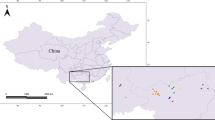Abstract
The cave molly, Poecilia mexicana, from the Cueva del Azufre, a sulfur cave in Tabasco, Mexico, ranks among the best-studied cave fishes worldwide, despite being known from a single population only. Here we describe a newly discovered second population of cave-dwelling P. mexicana from a nearby, but mostly non-sulfidic cave (Luna Azufre). Despite apparent similarities between the two populations (such as reduced eye diameter and reduced pigmentation), a geometric morphometric analysis revealed pronounced morphological differentiation between the two cave forms.




Similar content being viewed by others
References
Abdel-Latif H, Hassan E, von Campenhausen C (1990) Sensory performance of blind Mexican cave fish after destruction of the canal neuromasts. Naturwissenschaften 77:237–239
Bagarinao T (1992) Sulfide as an environmental factor and toxicant: tolerance and adaptations in aquatic organisms. Aquat Toxicol 24:21–62
Burt de Perera T (2004) Spatial parameters encoded in spatial map of the blind Mexican cave fish, Astyanax fasciatus. Anim Behav 68:291–295
Cline JD (1969) Spectrophotometric determination of hydrogen sulfide in natural waters. Limnol Oceanogr 14:454–458
Gordon MS, Rosen DE (1962) A cavernicolous form of the poeciliid fish Poecilia sphenops from Tabasco, México. Copeia 1962:360–368
Grieshaber MK, Völkel S (1998) Animal adaptations for tolerance and exploitation of poisonous sulfide. Ann Rev Physiol 60:33–53
Jeffery WR (2005) Adaptive evolution of eye degeneration in the Mexican blind cavefish. J Heredity 96:185–196
Körner KE, Schlupp I, Plath M, Loew ER (2006) Spectral sensitivity of mollies: comparing surface- and cave-dwelling Atlantic mollies, Poecilia mexicana. J Fish Biol 69:54–65
Langecker TG, Wilkens H, Parzefall J (1996) Studies on the trophic structure of an energy-rich Mexican cave (Cueva de las Sardinas) containing sulfurous water. Mémoires de Biospéologie 23:121–125
Miller RR (2005) Freshwater fishes of Mexico. University of Chicago Press, Chicago
Parzefall J (1970) Morphologische Untersuchungen an einer Höhlenform von Mollienesia sphenops (Pisces, Poeciliidae). Zeitschrift für Morphologie der Tiere 68:323–342
Parzefall J (1973) Attraction and sexual cycle of poeciliids. In: Schroeder J (ed) Genetics and mutagenesis of fish, Springer Verlag, Berlin, pp 177–183
Parzefall J (1993) Behavioural ecology of cave-dwelling fishes. In: Pitcher TJ (ed) Behaviour of teleost fishes, 2nd edn. Chapman and Hall, London, pp 573–608
Parzefall J (2001) A review of morphological and behavioural changes in the cave molly, Poecilia mexicana, from Tabasco, Mexico. Environ Biol Fishes 62:263–275
Peters N, Peters G, Parzefall J, Wilkens H (1973) Über degenerative und konstruktive Merkmale bei einer phylogenetisch jungen Höhlenform von Poecilia sphenops (Pisces, Poeciliidae). Internationale Revue der Gesamten Hydrobiologie 58:417–436
Pisarowicz J (2005) Return to Tabasco. Assoc Mexican Cave Studies Newslett 28:27–57
Plath M, Hauswaldt JS, Moll K, Tobler M, García de León FJ, Schlupp I, Tiedemann R (2007) Local adaptation and pronounced genetic differentiation in an extremophile fish, Poecilia mexicana, inhabiting a Mexican cave with toxic hydrogen sulfide. Mol Ecol 16:967–976
Plath M, Heubel KU, García de León FJ, Schlupp I (2005) Cave molly females (Poecilia mexicana, Poeciliidae, Teleostei) like well-fed males. Behav Ecol Sociobiol 58:144–151
Plath M, Parzefall J, Körner KE, Schlupp I (2004) Sexual selection in darkness? Female mating preferences in surface- and cave-dwelling Atlantic mollies, Poecilia mexicana (Poeciliidae, Teleostei). Behav Ecol Sociobiol 55:596–601
Plath M, Parzefall J, Schlupp I (2003) The role of sexual harassment in cave- and surface-dwelling populations of the Atlantic molly, Poecilia mexicana (Poeciliidae, Teleostei). Behav Ecol Sociobiol 54:303–309
Poulson TL (1963) Cave adaptation in amblyopsid fishes. Am Midland Naturalist 70:257–290
Poulson TL, Lavoie KH (2000) The trophic basis of subterranean ecosystems. In: Wilkens H, Culver DC, Humphries WF (ed) Ecosystems of the world 30: subterranean ecosystems, Elsevier Science, Amsterdam, pp 231–249
Proudlove G (2006) An account of the subterranean (hypogean) fishes described up to 2003 with a bibliography 1541–2004. International Society for Subterranean Biology, Moulis
Rohlf F (2004) tpsDig. Available from http://life.bio.sunysb.edu/morph/
Rohlf F (2005) tpsRegr. Available from http://life.bio.sunysb.edu/morph/
Rohlf F (2006) tpsUtil. Available from http://life.bio.sunysb.edu/morph/
Romero A, Green SM (2005) The end of regressive evolution: examining and interpreting the evidence from cave fishes. J Fish Biol 67:3–31
Strecker U, Bernatchez L, Wilkens H (2003) Genetic divergence between cave and surface populations of Astyanax in Mexico (Characidae, Teleostei). Mol Ecol 12:699–710
Tobler M, Schlupp I, Heubel KU, Riesch R, García de León FJ, Giere O, Plath M (2006) Life on the edge: Hydrogen sulfide and the fish communities of a Mexican cave and surrounding waters. Extremophiles 10:577–585
Walters L, Walters V (1965) Laboratory observations on a cavernicolous poeciliid from Tabasco, Mexico. Copeia 1965:214–233
Wilkens H, Strecker U (2003) Convergent evolution of the cavefish Astyanax (Characidae, Teleostei): genetic evidence from reduced eye-size and pigmentation. Biol J Linnean Soc 80:545–554
Zeiske E (1968) Prädispositionen bei Mollienesia sphenops (Pisces, Poeciliidae) für einen Übergang zum Leben in subterranen Gewässern. Z Vgl Physiol 58:190–222
Acknowledgments
We are grateful to the people of Tapijulapa for their hospitality during our visits. K. Henker, N. Hines and V. Siegel kindly introduced us to the Luna Azufre. L. Krumholz helped in the lab and provided the infrastructure for sulfide measurements, T. J. DeWitt gave helpful advice for the geometric morphometric analysis, and M. Schartl as well as two reviewers provided useful comments on an earlier version of the manuscript. The Mexican government kindly issued a permit to conduct this research (Permiso de pesca de fomento number DGOPA/16988/191205/-8101). Financial support came from the University of Oklahoma, the DFG (SCHL 344/15-1; PL 470/1-1), the German Ichthyological Association (to M.T. and M.P) as well as the American Livebearer Association, the Basler Foundation for Biological Research, the Janggen-Poehn Foundation, the Roche Research Foundation, and the Wolfermann-Nägeli-Foundation (to M.T.).
Author information
Authors and Affiliations
Corresponding author
Rights and permissions
About this article
Cite this article
Tobler, M., Riesch, R., García de León, F.J. et al. A new and morphologically distinct population of cavernicolous Poecilia mexicana (Poeciliidae: Teleostei). Environ Biol Fish 82, 101–108 (2008). https://doi.org/10.1007/s10641-007-9258-x
Received:
Accepted:
Published:
Issue Date:
DOI: https://doi.org/10.1007/s10641-007-9258-x




